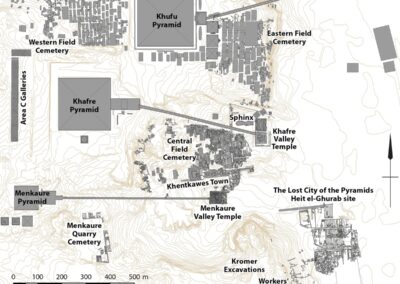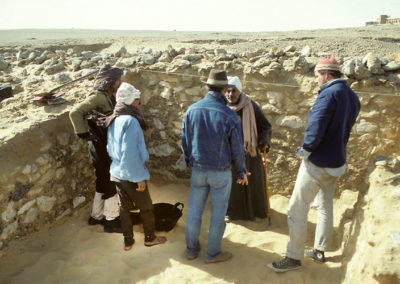Area C (Petrie’s Worker’s Barracks)
Era
4th Dynasty, Old Kingdom
Location
Giza Plateau
Project Dates
1988-1989
Previous Excavators
Sir Flinders Petrie

The location of Area C on the Giza Plateau
In his book, The Pyramids and Temples of Gizeh (1883), Sir W.M. Flinders Petrie wrote of excavating inside these huge comb-like galleries just west of Khufu’s pyramid, and he stated unequivocally that these were workmen’s barracks. But was his analysis correct? In order to test Petrie’s hypothesis, which had been accepted by Egyptologists for over 100 years, we proposed to re-excavate Petrie’s barrack galleries along with two other areas at Giza in our search for the pyramid builders’ settlement.
During the 1988–1989 season, we started our search by examining the three likely areas:
- Area A — the area south of the Wall of the Crow (or Heit el-Ghurab in Arabic)
- Area B — Kromer’s Dump Site
- Area C — Petrie’s Worker’s Barracks
Project head Mark Lehner did not expect to find actual “workmen’s barracks” in Area C, but we still excavated here in order to investigate Petrie’s claim. We found that Area C contained mostly empty spaces with some evidence of activity at the entrances and just inside the galleries. Rather than barracks, we proposed that these galleries were probably used for storage and some craft work, most likely while the Khafre pyramid was under construction.
We ultimately discovered that Area A, which has become known as The Lost City of the Pyramids (or Heit el-Ghurab), was the true location of the pyramid workers settlement. Read more about our search for the settlement and infrastructure that accommodated the ancient Egyptian pyramid builders in the article Searching for a City.
Area C Photogallery
The Area C galleries (left of the modern road) shown in relation to Khafre’s pyramid (far right). View to the north.
Selected Bibliography
2001. Conard, Nicholas J., and Mark Lehner. “The 1988/1989 Excavation of Petrie’s Workmen’s Barracks at Giza.” Journal of the American Research Center in Egypt vol. 38, pages 21–60.
2001. Lehner, Mark. “The Other Galleries: Built for the Living or the Dead?” AERAGRAM vol 4 no 2, pages 8-11.




